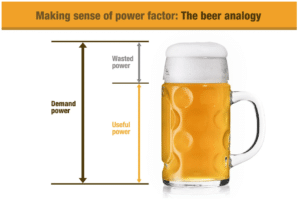Ever felt ripped off after being served up a beer with more head than you can shake a stick at? Then take a moment to consider how power wastage from your business’ equipment is as useless as the froth on your over-fizzed brew.
But what on earth has power factor got to do with beer I hear you say? And more importantly, what even is it?
Power factor in a nutshell… or a pint glass
Power factor is basically a measure of how efficiently your business sites use power supplied by your network distributor. Poor power factor = poor power efficiency and increased charges.
But for a more detailed, um, ‘scientific’ explanation, let’s get back to that beer:

Beer = active power (kW) – the useful power, or the liquid beer is the energy doing the good work.
Foam = reactive power (kVAR). This is wasted or lost power. It’s the energy being produced that isn’t doing any work and is annoyingly inefficient.
The mug = apparent power (kVA). This is the demand power, or the power being delivered by the utility.
So, the more ‘foam’ on your power factor, the more power wastage and the higher your inefficiency. Poor power factor is bad news for your business, your carbon footprint, and the environment.
Power factor is expressed as a percentage – the lower the percentage, the less efficient your power usage.
For example, equipment with a power factor of 1 is using all the power supplied to it. Big tick. Generally, a power factor of 0.8 or above is considered good.
However, if your power factor is lower than 0.8, it should be corrected to save on consumption and comply with the requirements of the electricity network operator.
Paying hand over fist for power
Total Utilities Director Chris Hargreaves explains, “Your power supplier provides electricity to meet your demands. Therefore, if your apparent power needs are high in order to compensate for poor power factor, you – the customer – will end up paying through the nose for it.
“For some larger customers, power suppliers might even take the largest peak and apply it across the full billing period. So you’re paying a very high price indeed for that froth on your beer!
“Poor power factor can also cost your business through direct penalty charges applied by many electricity distributors in New Zealand. This combined with charges for apparent rather than actual power can result in sky-high utility bills – particularly in this current climate where the cost of power is going through the roof.
“Conversely, by reducing the amount of energy your site requires at any one time, you reduce demand and the cost of supplying energy to your site.”
So, how do I get a handle on my business’ power factor?
Before you start to tackle a power factor problem, it’s important to get a measure of how efficient your current equipment actually is.
Total Utilities provides power factor audits – complete health checks of the overall quality of your electrical network. Our power factor audits identify problem areas and suggest opportunities for improvement in order to maximise your energy savings, mitigate faults and increase system reliability and efficiency.
Total Utilities can save you money with power factor correction
If a problem is identified during our audit, installing power factor correction is a great option to reduce your demand charges.

Total Utilities works with Rotorua based power factor correction specialists KVAr Correct, to provide complete, custom, and ready-to-go power factor correction solutions, plus ongoing monitoring and maintenance. These modular systems are custom designed to meet each customer’s need, ensuring the best return and no wasted capacity.
So, if you’re looking to reduce costs and increase energy efficiency (and let’s face it, who isn’t?), maybe now’s the time to look into your power factor? Use less. Pay less. Reduce your carbon footprint.
It’s a win-win for your business, your bottom line and the planet.
- Contact Total Utilities to find out more about our power factor audits, services and solutions.
Sign up below for Total Utilities Market Commentary to receive all the latest market news and insights.
